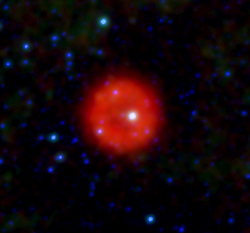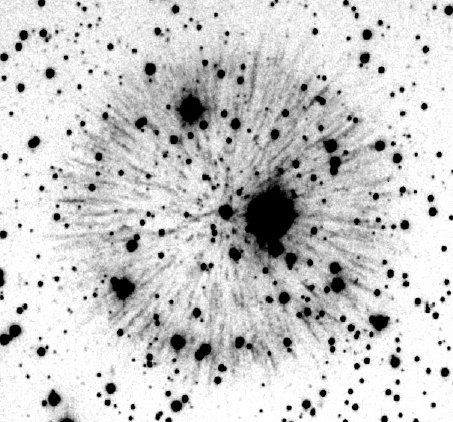Astronomy:IRAS 00500+6713
| Observation data Equinox J2000.0]] (ICRS) | |
|---|---|
| Constellation | Cassiopeia |
| Right ascension | 0h 53m 11.21s[1] |
| Declination | +67° 30′ 02.4″[1] |
| Apparent magnitude (V) | 15.4[2] |
| Astrometry | |
| Proper motion (μ) | RA: −2.258[1] mas/yr Dec.: −0.0988[1] mas/yr |
| Parallax (π) | 0.4065 ± 0.0259[1] mas |
| Distance | 8,000 ± 500 ly (2,500 ± 200 pc) |
| Details | |
| Mass | 1.20±0.17[3] M☉ |
| Radius | 0.155[3] R☉ |
| Luminosity | 36,000[3] L☉ |
| Temperature | 237,000[3] K |
| Database references | |
| SIMBAD | data |
IRAS 00500+6713 is the catalogued infrared source for an unusual nebula in Cassiopeia, while the central star has a designation WD J005311, with the whole system designated as Pa 30. The central star and its surrounding shell were created by the supernova seen in the year 1181 (SN 1181) as reported by Chinese and Japanese observers.[4] Both the nebula and central star have unique and extreme properties, pointing to their creation by a rare Type Iax supernova, where two ultra-dense white dwarfs in-spiral to a collision and explosion.[3] The Pa 30 system was discovered in 2013 by amateur astronomer Dana Patchick,[5] the extreme properties of the central star were first seen in 2019 by Gvaramadze and colleagues, and they recognized that the system was created in a low-luminosity supernova event from a merger of two white dwarfs.[6]
The central star is a white dwarf with an extreme stellar wind, surrounded by a nebula packed with hot gas and warm dust.[7] The star represents a new kind of X-ray source.[8] It exhibits record-breaking wind speeds of 16,000 km/s and temperatures near 200,000 K.[9] Both the central star and the nebula contain large amounts of neon, magnesium, silicon, and sulfur at high velocities (but no hydrogen, helium, or nitrogen), with such requiring an origin in a recent supernova.[3] The central star, might be a rapidly-rotating super-Chandrasekhar white dwarf with a mass ≳1.5 M☉. The surrounding shell has a unique structure with long radial filaments that have expansion velocities of around 1100 km/s.[10] Apparently, the filaments are the tattered remains of the original `slow' supernova ejecta, fragmented and streamed into long wakes by the on-going very fast stellar wind emanating from the central white dwarf.
The Pa 30 structure is classified as an unusual type of supernova remnant, likely to have been created by the merger of two white dwarfs. The supernova event itself was a rare type Iax, the only one observed in the Milky Way. It has been linked to the supernova SN 1181.[4] The star is possibly highly unstable, too massive to remain as a white dwarf, and it is predicted to collapse into a neutron star within ten thousand years.[11]

References
- ↑ 1.0 1.1 1.2 1.3 1.4 Vallenari, A. et al. (2022). "Gaia Data Release 3. Summary of the content and survey properties". Astronomy & Astrophysics. doi:10.1051/0004-6361/202243940 Gaia DR3 record for this source at VizieR.
- ↑ Fedorov, P. N.; Akhmetov, V. S.; Bobylev, V. V. (2011). "Residual rotation of the Hipparcos/Tycho-2 system as determined from the data of the XPM catalogue". Monthly Notices of the Royal Astronomical Society 416 (1): 403. doi:10.1111/j.1365-2966.2011.19045.x. Bibcode: 2011MNRAS.416..403F.
- ↑ 3.0 3.1 3.2 3.3 3.4 3.5 Oskinova, Lidia M.; Gvaramadze, Vasilii V.; Gräfener, Götz; Langer, Norbert; Todt, Helge (2020-12-01). "X-rays observations of a super-Chandrasekhar object reveal an ONe and a CO white dwarf merger product embedded in a putative SN Iax remnant" (in en). Astronomy & Astrophysics 644: L8. doi:10.1051/0004-6361/202039232. ISSN 0004-6361. Bibcode: 2020A&A...644L...8O.
- ↑ 4.0 4.1 Ritter, Andreas; Parker, Quentin A.; Lykou, Foteini; Zijlstra, Albert A.; Guerrero, Martín A.; Le Dû, Pascal (2021). "The Remnant and Origin of the Historical Supernova 1181 AD". The Astrophysical Journal 918 (2): L33. doi:10.3847/2041-8213/ac2253. Bibcode: 2021ApJ...918L..33R.
- ↑ Kronberger, M. (2014). "New Planetary Nebulae and Candidates from Multicolour Multiwavelength Surveys". Asymmetrical Planetary Nebulae VI conference. http://www.astroscu.unam.mx/apn6/PROCEEDINGS/B3-Kronberger.pdf.
- ↑ Gvaramadze, Vasilii V. (2019). "A massive white-dwarf merger product before final collapse". Nature 569 (7758): 684–687. doi:10.1038/s41586-019-1216-1. PMID 31110332. Bibcode: 2019Natur.569..684G.
- ↑ "This 'Unusual Star' Is Unlike Anything Astronomers Have Seen Before" (in en-us). 5 January 2021. https://gizmodo.com/this-unusual-star-is-unlike-anything-astronomers-have-1845994482.
- ↑ Agency, European Space (2021-01-11). "Cosmic Neon Lights: Strange New Type of Star Revealed in X-ray Light" (in en-US). https://scitechdaily.com/cosmic-neon-lights-strange-new-type-of-star-revealed-in-x-ray-light/.
- ↑ "Strange star unlike any seen before, scientists say" (in en-US). https://room.eu.com/news/strange-star-unlike-any-seen-before-scientists-say.
- ↑ Fesen, Robert A.; Schaefer, Bradley E.; Patchick, Dana (2023-01-11). "Discovery of an Exceptional Optical Nebulosity in the Suspected Galactic SN Iax Remnant Pa 30 Linked to the Historical Guest Star of 1181 CE". The Astrophysical Journal Letters 945 (1): L4. doi:10.3847/2041-8213/acbb67. Bibcode: 2023ApJ...945L...4F.
- ↑ "Brilliant X-rays reveal what might be a new type of star". Nature 589 (7841): 172. 2021. doi:10.1038/d41586-020-03654-x. Bibcode: 2021Natur.589S.172..
 |


